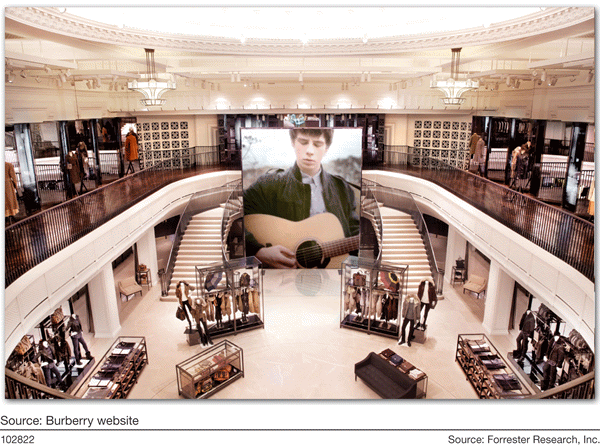Why Infrastructure Will Drive The Retail Store Experiences Of The Future
The Infrastructure and Operations (I&O) role is changing significantly: I&O pros are increasingly helping to drive business strategies with the technologies they choose and implement. Business leaders tell Forrester that technology is too important to leave to technology managers alone; they are pushing their I&O colleagues to explore the business value associated with the technologies they choose, implement, and manage. I&O pros, in turn, tell us that their jobs are changing. As one I&O pro put it, “I’ve been an infrastructure manager for 15 years, but only in the past 3 have I been asked to construct a business plan and be part of the business planning team.”
Figure: Burberry's Technology-Powered Flagship Store In London

For I&O pros in retail and related verticals like hospitality (or for anyone involved in creating in-person experiences), we’ve just released a report to help aid this transition. Along with my co-author Michele Pelino, we’ve just released the report “Infrastructure Will Drive The Retail Store Experiences Of The Future.” The report asserts that I&O pros have an important role to play in helping their companies engage shoppers in experiences that will drive loyalty and spending.
Technologies like wearables, RFID tagging, iBeacon, interactive digital displays, and facial recognition (to name just a few) are reshaping the way retailers craft in-store experiences for their customers. Retailers are constantly seeking technologies to both bolster customer experience and increase efficiency – and of course the two are interrelated. In our report we discuss, for instance, how technology can support:
- Stores as social destinations. As one interviewee told Forrester, “In-store experiences can offer a quality of 'ceremony' — that is, the act of experiencing something you wouldn't easily get online. Stores can become social gathering places, pleasurable to visit from start to finish.” Technology plays a role in making some retail stores, like the Apple Store or Burberry’s flagship store, a destination to be explored and enjoyed.
- Stores as efficient fulfillment centers. In other cases, retailers are evolving into service centers as omnichannel commerce brings together virtual and physical worlds. Yet the same in-store technologies are critical to bolstering service experiences for fulfillment of cross-channel sales.
To execute this vision of in-store experiences powered by technology, retailers need to leverage the critical skill sets of both business leaders and I&O professionals. To ensure that the best technologies are chosen — and then that those technologies work consistently — I&O must bring its expertise to the table.
Why? Because there are risks to ceding technology decisions to marketers and other business leaders alone. As in-store technologies are increasingly supported by a network, for example, I&O’s input is crucial. The VP of IT at a luxury retailer told Forrester, “The network is so critical to us that if it were to go out, it's the equivalent of the store losing power.” Yet if I&O isn’t involved in every phase of the technology decisions in the store, in the usage models and dependencies, they won’t be able to manage the network effectively. And I&O can separate hype from fiction when evaluating emerging, new technologies as well, helping the business make innovative decisions that can perform for customers. Some of these technologies, they can learn about by reading our report.
We invite you to read and download our full report here.
J. P. Gownder is a vice president and principal analyst at Forrester Research serving Infrastructure & Operations Professionals. Follow him on Twitter at @jgownder
Michele Pelino is a principal analyst at Forrester Research serving Infrastructure & Operations Professionals. Follow her on Twitter at @mmpelino
